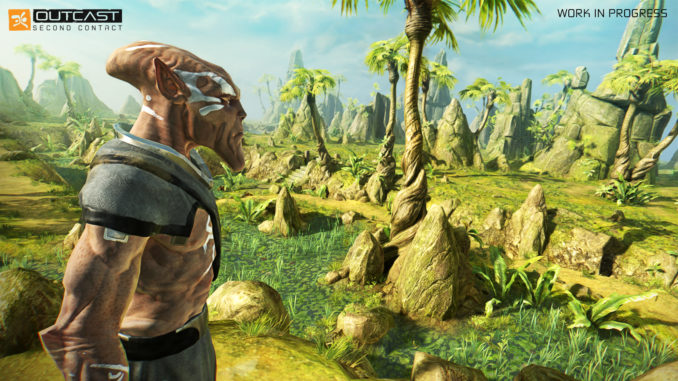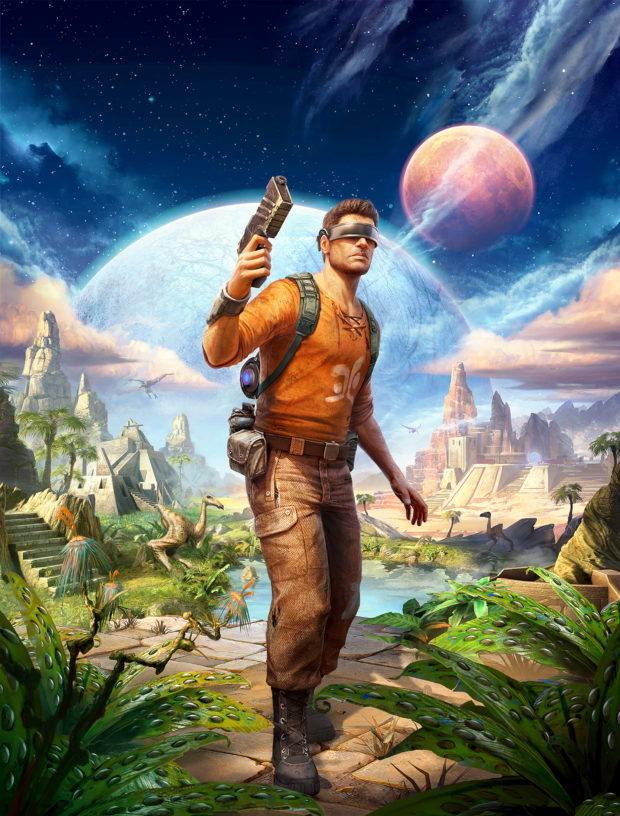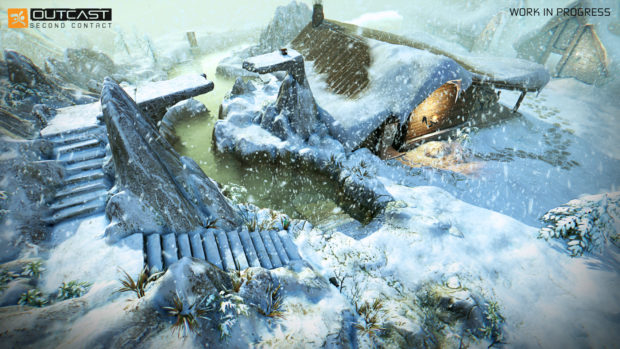
The purpose of a video game remake is to recreate an obsolete format with updated visuals and gameplay. “Outcast: Second Contact†is a perfect example of a game that never needed to be remade.
“Outcast†was a PC game released 1999 and was a pioneering example of how to make an open-world game with the hardware limitations of the time. Now that open-world game making is a lot more accessible, updated and refined game structure is to be expected. However, even in an age where you can draw inspiration from other great open-world games, “Second Contact†manages to decline in quality eighteen years later.
 “Outcast: Second Contact’s†presentation is interesting up to the first in-game cutscene, immediately becoming a disappointment. The game opens up with shots of a military captain-like character walking through a dimly lit hallway while a news report plays in the background, serving as an exceptional means of exposition and tone setting. The captain, whom we learn is Major Vernon, approaches the game’s protagonist, Cutter Slade, with news regarding the military’s newfound ability to contact another universe. Cutter must unwillingly agree to explore this new world with a team via a portal and retrieve a probe that was misplaced. Amongst his travels, he loses his teammates and must now explore the world, find his friends, his probe, and help the foreign alien-like village people from extinction. The stories concept is the only thing redeemable for this game. Once you meet the village people, you’re greeted with some of the most unaesthetic character models in any game to date, and you’ll be seeing and hearing from these characters throughout the entire game. If their lines were cut short, they’d likely be a lot more bearable.
“Outcast: Second Contact’s†presentation is interesting up to the first in-game cutscene, immediately becoming a disappointment. The game opens up with shots of a military captain-like character walking through a dimly lit hallway while a news report plays in the background, serving as an exceptional means of exposition and tone setting. The captain, whom we learn is Major Vernon, approaches the game’s protagonist, Cutter Slade, with news regarding the military’s newfound ability to contact another universe. Cutter must unwillingly agree to explore this new world with a team via a portal and retrieve a probe that was misplaced. Amongst his travels, he loses his teammates and must now explore the world, find his friends, his probe, and help the foreign alien-like village people from extinction. The stories concept is the only thing redeemable for this game. Once you meet the village people, you’re greeted with some of the most unaesthetic character models in any game to date, and you’ll be seeing and hearing from these characters throughout the entire game. If their lines were cut short, they’d likely be a lot more bearable.
For an open-world game, “Second Contact†feels incredibly restrictive. Your only means of mobility is one set running speed and an awkwardly slow jump mechanic. This wouldn’t be so bad if the landscapes weren’t as rigid and vertically scaled as they are; you’ll find yourself having to walk up small hills or even concrete steps (that are placed on some rocks, making the world feel less authentic) just to scale something that seems jumpable. The fall damage is unforgiving, and you’ll find yourself taking damage from jumping off that same small rock you were barely able to scale. Cutter Slade is given an identity and history of professional combat and survival, so making him this frail completely shatters any player to character connection you may have had. These standards of gaming may not have held preeminence in 1999, but in 2017, games like “The Legend of Zelda: Breath of the Wild,†and “Horizon Zero Dawn†have shown us the new standard for open world quality. Taking a few digital pages from these games, the mechanics could have been a lot more refined.
 Your main objectives are to take out enemy bases and travel through their portal to reach another part of the world. The game promotes stealth and third-person shooting, much like “Uncharted.†The game’s answer to its poor A.I is its sheer amount of enemy placement in one area. Its answer to poor aiming controls and abysmal camera angles is having the enemy hitbox a large square twice their size surrounding them. If you’re able to pick up some of the best guns in the game, you have no incentive to utilize stealth. This isn’t to mention the fact that once you’re spotted, you can’t be unspotted by hiding again, leaving even less of an incentive to be stealthy.
Your main objectives are to take out enemy bases and travel through their portal to reach another part of the world. The game promotes stealth and third-person shooting, much like “Uncharted.†The game’s answer to its poor A.I is its sheer amount of enemy placement in one area. Its answer to poor aiming controls and abysmal camera angles is having the enemy hitbox a large square twice their size surrounding them. If you’re able to pick up some of the best guns in the game, you have no incentive to utilize stealth. This isn’t to mention the fact that once you’re spotted, you can’t be unspotted by hiding again, leaving even less of an incentive to be stealthy.
“Outcast: Second Son†does little to innovate and only proceeds to carry over, and in some cases worsen obsolete ideas. The world doesn’t feel any more enriched than its predecessor, and the controls and combat are an overall worse experience. The game just fails to live up to the modern day advantages we’re given in terms of technology.

Leave a Reply